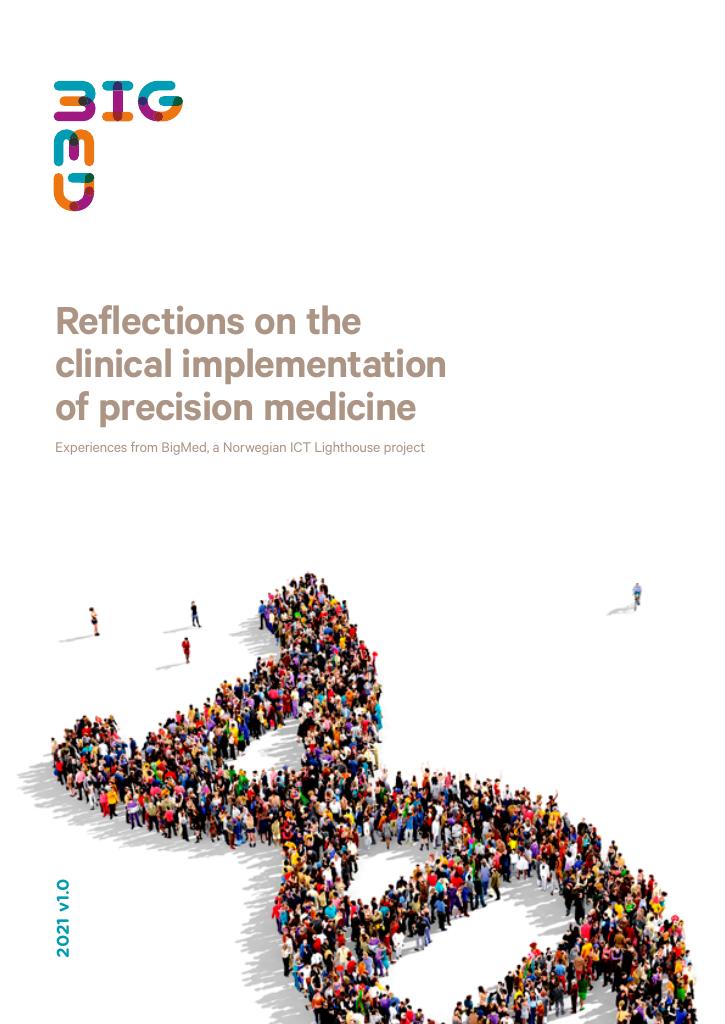Statusrapport
Reflections on the clinical implementation of precision medicine : Experiences from BigMed, a Norwegian ICT Lighthouse project Experiences from BigMed, a Norwegian ICT Lighthouse project
The BigMed project was funded by The Research Council of Norway (RCN) as an ICT lighthouse project to address the barriers to clinical implementation of precision medicine and pave the way for big data analytics. The consortium, hosted by Oslo University Hospital, was a cooperation of more than 20 partners from industry, academia, and the clinic. In the four years BigMed operated, the multidisciplinary teams developed solutions on infrastructure, quality assurance, data sharing and clinical decision support based on needs identified through three clinical areas: rare diseases, sudden cardiac death, and colorectal cancer. In developing a framework for addressing different types of implementation barriers, BigMed considered legal issues, organisational and governance issues, ICT infrastructure, as well as the life cycle of secondary use of data through data capture, analysis, and application. The project found data is a resource that is seldom reused for clinical decision support. Clinical genomics is an exception and serves as a good example of how data can be reused to support clinical decisions. This can be a model for future development of other areas, to see how data can be used for patient similarity analysis and to speed up knowledge development to the benefit of our patients. BigMed contributed to reducing the genetic analysis time for critically ill newborns at (OUH) from 8 weeks to 5 days by developing tools to support the implementation and automatisation of high throughput sequencing pipelines. To monitor quality, BigMed explored quality control needs and specific tools, and developed and implemented solutions for sharing of genomic data. The legal aspects of sharing genomic data were interpreted and clarified to make implementation possible. The project developed patient similarity tools for colorectal cancer, building on data from external sources like the Cancer Registry of Norway. These analytic tools supporting clinical decisions were coupled with genomic reporting tools in a dashboard to gather all relevant patient information in a timeline. This clinical case demonstrates the need for data mobility and the benefit of reusing data for clinical decisions. Based on the case of sudden cardiac death and the need for early identification of patients at risk, we demonstrated the use of Natural language processing (NLP) to pull relevant information from Electronic Health Records (EHR) in order to populate analysis tools and automate risk estimation. Synthetic data proved successful for the first phase of training tools. Our experiences reveal a need to develop strategies on how best to use data and what infrastructure needs to be in place. Data must be captured in formats that allow for reuse. Raw data should be saved as well, as a lot of value may get lost in the translation from raw data to structured variables. NLP will provide a useful tool to interpret the information hidden in clinical text, yet need to be developed in one area at a time. Data must be allowed to flow between systems to allow for the successful development and implementation of tools and processes that support a precision medicine approach. This flow will be facilitated by defined standards, APIs, and suitable open platforms. There is a significant technology debt in the existing infrastructure that needs to be addressed as we move forward. Adoption of precision medicine is best executed with an iterative approach and incremental changes. This is best accomplished through an agile management approach and establishment of a clear path from innovation to implementation, rather than a hierarchical decision structure. This innovation ecosystem requires the hospitals and technology providers to work together towards a common goal. New models for clinical studies are needed to adapt to the precision medicine paradigm, and health economic models must be revised to reflect the individual rather than a group approach. The current healthcare regulations are fragmented. Essentially, the main rule is that data should not be reused. The many necessary exceptions to this rule make it a difficult landscape to operate in for both healthcare professionals and researchers. A holistic approach to regulating how data can be reused in a safe and balanced way would support development and benefit the patients rather than create barriers. Clinical decision support (CDS) tools powered by Artificial Intelligence (AI) will be regulated under the EU Medical Device Regulation (MDR) and In-Vitro Diagnostic Regulation (IVDR), yet more supporting systems for safe use are needed. The need for ICT competence near the clinic will increase, as diagnostics move towards more of a multi competence team process. Moving forward, more specialised initiatives that follow BigMed will continue developing solutions and bringing important discussion topics to the stakeholders and the public. The right setup for allowing incremental changes in our system will allow us to continue working towards our common goal of implementing precision medicine in the healthcare system for the benefit of our patients.
Publisert
Eier
Norges forskningsråd
Forfattere
Pål Brekke, Alia Zaka, Vibeke Binz Vallevik, Bobbie Ray-Sannerud og Erik Fosse
Språk
norsk (bokmål)
Kilde
ISBN
9788247300916
